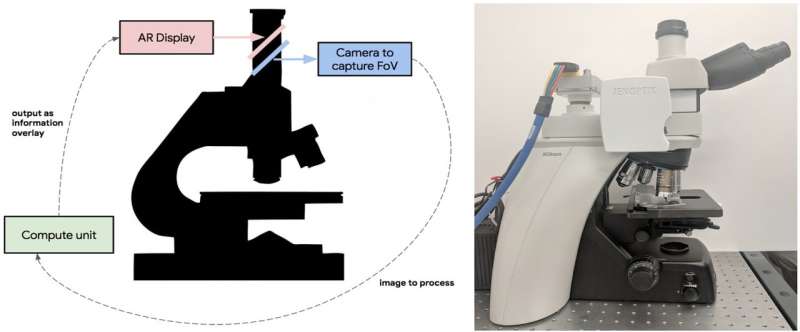April 17, 2018 report
Combining augmented reality with deep learning network to help pathologists spot cancer cells

A team of researchers at Google has developed a tool that combines augmented reality with a deep learning neural network to provide pathologists with help in spotting cancerous cells on slides under a microscope. Google has published a paper outlining the new tool, which they describe as an augmented reality microscope (ARM) platform, on their website. They also gave a presentation at this year's American Association for Cancer Research meeting, showing what it can do.
Performing a biopsy entails slicing tiny bits of tissue from a part of the body doctors suspect might be cancerous. That tissue is sliced thinly enough to view on a glass slide under a microscope by a highly trained pathologist looking for cancerous cells. The job of the pathologist, the Google team notes, is highly valued, but the work is also tedious, which can lead to fatigue and errors. To help the pathologist, the team at Google built on prior work at the company in which a team developed a deep learning network that was trained to spot breast cancer. The team then incorporated lessons learned from various projects surrounding augmented reality to train their deep learning application to draw circles around suspected cancer cells in a tissue sample. They interfaced their system with the type of microscope pathologist already use. The result is an add-on tool for the microscope. It works like this: Through the microscope, the pathologist sees the cells of the tissue—moving the slide around allows them to see the whole sample. But then,if the ARM spots possible cancer cells, it draws a ring around them, alerting the pathologist to take a closer look.
The ARM, Google reports, is now capable of assisting with detecting breast and prostate cancers, but they note that it could be trained to spot other cancers, as well. It could even be trained to look for some types of infectious diseases such as TB and malaria. They note also that it could also be programmed with other AR capabilities, such as posting labels over certain tissue sections, including arrows or other indicators pathologists might find useful.
© 2018 Phys.org
















